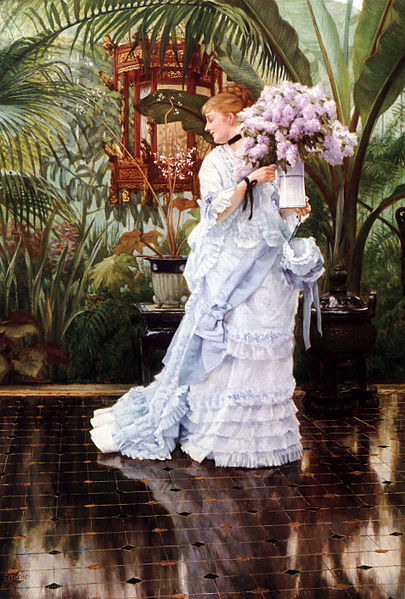During the Victorian era, garden design was over the top - in a good way unless you were a minimalist. The above example is the layered look using tropicals in a round bed. To achieve this look, the round plot needs very big and tall plants in the middle.
Very large annuals are not typically native to the Midwest unless you use grasses. Grasses can work, but, I'm talking about the large and distinctive leafed plants. The ones that look like they just came from the rain forests.
I've found very few local nurseries offering much of a variety of large leafed plants.
Hornbaker Nursery, Princeton IL, does carry several large variety hosta if your plot will be in partial shade. I do find that hosta tends to drape over too much for the above type design. If you're looking for a perennial bed in some shade, keep in mind the width of these large hosta (such as "Empress Wu", "Glory" and "Golden Sculpture") and plant the next row farther away. Also, a perennial bed of this design will take a year or so to get established and picture perfect.
If the local nurseries in your area don't stock what you want and are reluctant to stock, turn to catalogs and on line sites. I'll do my usual caution: don't order fifty bulbs unless you've confidence in the nursery.
I was amazed at the www.floridahillnursery.com site's variety of Alocasia and Colocasia elephant ear plants! For the above type display, the elephant ear plant would need to be tall. If you choose one of the variegated varieties, it will help determine the colors of the other plants in this design. I'm quite taken with the red stemmed varieties such as their Colocasia Cranberry pictured here. Additionally, they have white stemmed/veined, all black, irregular mottled, and chartreuse.
Elephant ear does best in bright indirect sun or morning sun. This pairs them well with Caladium; another large leafed but shorter annual. There's a large color variety of Caladium and choices to go with most any design you can imagine.
Another large plant is the Canna x generalis. There are variegated and striped leafed varieties, plus, flowers of orange, yellow, peach, red, orange and white. Use the Canna in full sun locations.
The ricinus communis Caster Oil Bean plant is controversial because all parts are poisonous. If you have children or pets that could eat them, I'd pass on this beauty. Seldom can you find the seeds in nurseries or on line because of the safety issue. Most of mine have been from friends who save the seeds and share/replant. www.selectseeds.com has a few varieties as shown in this photo.
Caster Oil Bean plants are very tropical looking and have immense leaves resembling a hand spread out flat. Varieties come in green, decorative white ribbing, purple, and chocolate red. Plant these in full sun.
There are other tropical plants that would look good in the middle of this arrangement. If you choose tropical trees such as Burgmansia, palm, banana, and etc., I'd advise planting in pots to make it easier to bring in the house before frost.
 All of the above plants can be preserved over winter by potting, saving the bulbs or gathering seeds. These plants and the quantity needed for a display such as above, is not an inexpensive bed. Overwintering is a good way to cut the annual expense.
All of the above plants can be preserved over winter by potting, saving the bulbs or gathering seeds. These plants and the quantity needed for a display such as above, is not an inexpensive bed. Overwintering is a good way to cut the annual expense.It's not recommended to use seeds for this kind of display bed. Seldom do the plants reach maturity or bloom at the same time and the desired effect is never quite achieved especially in the Midwest where the growing season isn't all that long. If you are living in a warmer zone, your options for this kind of a bed are larger.
To get any mixed bed to look good, all plants need to have the same requirements - soil, light, water, fertilization. Many of the companion and smaller plants for the edges can be from local nurseries. All look best if they don't spread a lot. Prepare the soil using suggested amendments necessary for tropical plants. I typically fertilize with fish emulsion. Some require tropical dampness while others will rot if watered too much. Use LOTS of organic mulch.
Hard edging is optional. I've seen this type of bed planted in old cement ponds.
The thing to keep in mind is this particular look is Victorian in design. It's balanced, bold, formal and seldom has flowers. It's not rustic, light, cute, pastel or crowded into other beds. Which doesn't mean you have to follow the "rules" ~ it's your garden.




No comments:
Post a Comment